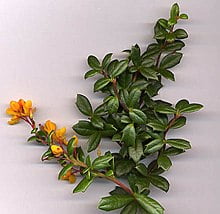Berberis

Berberis (/ˈbɜːrbərɪs/), commonly known as barberry,[1][2] is a large genus of deciduous and evergreen shrubs from 1–5 m (3.3–16.4 ft) tall, found throughout temperate and subtropical regions of the world (apart from Australia). Species diversity is greatest in South America and Asia; Europe, Africa and North America have native species as well. The best-known Berberis species is the European barberry, Berberis vulgaris, which is common in Europe, North Africa, the Middle East, and central Asia, and has been widely introduced in North America. Many of the species have spines on the shoots and all along the margins of the leaves.[3][4]
The genus Berberis has dimorphic shoots: long shoots which form the structure of the plant, and short shoots only 1–2 mm (0.039–0.079 in) long. The leaves on long shoots are non-photosynthetic, developed into one to three or more spines[5]:96 3–30 mm (0.12–1.18 in) long. The bud in the axil of each thorn-leaf then develops a short shoot with several normal, photosynthetic leaves. These leaves are 1–10 cm (0.39–3.94 in) long, simple, and either entire, or with spiny margins. Only on young seedlings do leaves develop on the long shoots, with the adult foliage style developing after the young plant is 1–2 years old.[citation needed]
Many deciduous species, such as Berberis thunbergii and B. vulgaris, are noted for their attractive pink or red autumn color. In some evergreen species from China, such as B. candidula and B. verruculosa, the leaves are brilliant white beneath, a feature valued horticulturally. Some horticultural variants of B. thunbergii have dark red to violet foliage.[citation needed]
The flowers are produced singly or in racemes of up to 20 on a single flower-head. They are yellow or orange, 3–6 mm (0.12–0.24 in) long, with six sepals and six petals in alternating whorls of three, the sepals usually colored like the petals. The fruit is a small berry 5–15 mm (0.20–0.59 in) long, ripening red or dark blue, often with a pink or violet waxy surface bloom; in some species, they may be long and narrow, but are spherical in other species.[citation needed]
Some authors regard the compound-leaved species as belonging to a different genus, Mahonia. There are no consistent differences between the two groups other than the leaf pinnation (Berberis sensu stricto appear to have simple leaves, but these are in reality compound with a single leaflet; they are termed “unifoliolate”[6]), and many botanists prefer to classify all these plants in the single genus Berberis.[3][7][8][9] However, a recent DNA-based phylogenetic study retains the two separate genera, by clarifying that unifoliolate-leaved Berberis s.s. is derived from within a paraphyletic group of shrubs bearing imparipinnate evergreen leaves, which the paper then divides into three genera: Mahonia, Alloberberis (formerly Mahonia section Horridae), and Moranothamnus (formerly Berberis claireae); it confirms that a broadly-circumscribed Berberis (that is, including Mahonia, Alloberberis, and Moranothamnus) is monophyletic.[10]
